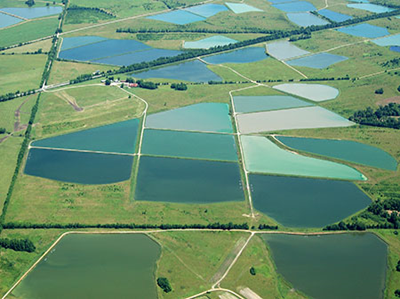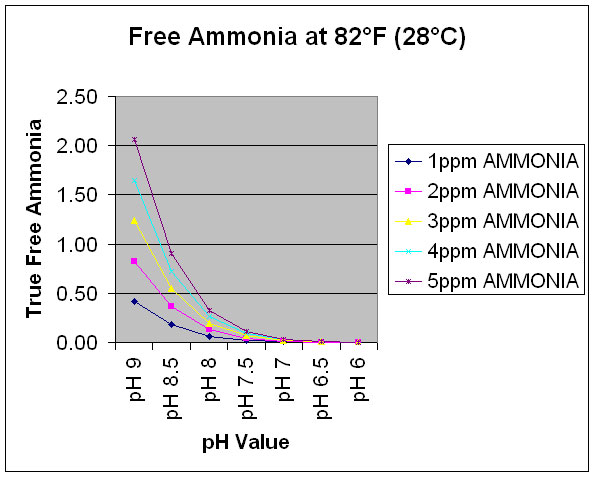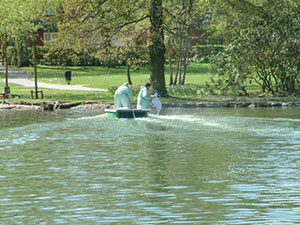Ammonia in Aquaculture Ponds
Understanding ammonia and controlling it is critical in aquaculture systems. If allowed to accumulate, ammonia is toxic to fish and can be detrimental to any fish production system. Once ammonia reaches toxic levels, fish are incapable of extracting needed energy from their feed. If the ammonia gets to a high enough quantity, the fish will eventually become slow, lethargic, and eventually succumb to these high levels resulting in possible death.
In a properly managed aquaculture pond setting, ammonia seldom accumulates to lethal concentrations. However, ammonia can have negative effects that don’t result in death but cause reduced growth rates, poor feed conversion, and reduced disease resistance. So, even though the fish don’t die directly from ammonia toxicity, it can affect the system in other ways and ultimately affect the overall crop.
Ammonia Dynamics
A single one-time measurement of ammonia concentration provides only a snapshot in time that the sample is measured. The processes that produce, remove and transform ammonia are complex and can change throughout the year. Sampling at different times and logging that data can provide more detailed, accurate information into the processes that affect your aquaculture system. 
The main source of ammonia is simply added through fish excretion. The excrement rate is directly related to the feeding rate and the protein level in the feed being used. As the feed’s protein is broken down in the fish’s body, some of the nitrogen is used to form a protein (muscle), energy, and excreted through the gills as ammonia. The protein in feed is the ultimate source of most ammonia in ponds where fish are fed.
Another main source of ammonia is the diffusion from the pond's sediment itself. Large amounts of organic matter are produced by algae or added to ponds as feed. Fecal solids and dead algae settle to the pond bottom and begin the process of decomposition. This process produces ammonia which diffuses from the sediment bottom into the water column.
Ammonia Sinks
Luckily, there are a couple of processes that also result in the loss or transformation of ammonia. The most important process is the loss of ammonia through the uptake by algae and other plants. Plants use nitrogen as a nutrient for growth. Photosynthesis acts like a sponge for ammonia uptake so overall plant or algae growth in the ponds can help use up ammonia. Of course, excessive plant growth can have an effect on the diurnal cycles of dissolved oxygen levels causing DO to go very low during nighttime hours.
The other ammonia removal process is the transformation of ammonia through nitrification. Two main types of bacteria, Nitrosomonas and Nitrobacter, effectively oxidize ammonia in a two-step process. First, they convert ammonia to nitrite (NO2-) and then to nitrate (NO3-). Essentially, nitrification is a process of nitrogen compound oxidation (effectively, loss of electrons from the nitrogen atom to the oxygen atoms).
Several factors affect nitrification rates and understanding these and measuring ammonia at various times will provide a much better understanding for clear management decisions. Ammonia concentration, temperature, and dissolved oxygen concentration all play a major role.
During summer, ammonia concentration is typically very low and so nitrification rates are also very low along with bacterial populations to handle excess ammonia. During winter, low temperature suppresses microbial activity. However, during the spring and fall, ammonia concentrations and temperature are at levels that favor higher nitrification rates. Spring and fall have common peaks in nitrate concentrations in many fish ponds.
Greatest Likelihood of Ammonia Problems
The U.S. Environmental Protection Agency (EPA) has established three kinds of criteria (one acute and two chronic) for ammonia (nitrogen), based on the duration of exposure. The acute criterion is a 1-hour average exposure concentration and is a function of pH.
One chronic criterion is the 30-day average concentration and is a function of pH and temperature.
The other chronic criterion is the highest 4-day average within the 30-day period and is calculated as 2.5 times the 30-day chronic criterion. The EPA criteria help determine when ammonia might be a problem.
Ammonia levels are heavily affected by changes in pH and temperature. Free ammonia is the toxic part of the Total Ammonia Nitrogen (TAN). Above pH of 8.0 the toxicity of the TAN rapidly rises. Source downloaded from Aquaworld Aquarium.

Contrary to common assumptions, ammonia concentration tends to be greater during the winter (2.5-4.0 mg/L or higher) than during summer (~0.5 mg/L). The 30-day chronic criterion for ammonia (nitrogen) in winter ranges from about 1.5-3.0 mg/L, depending on pH. Ammonia concentrations may exceed these concentrations during the winter months during a time when fish immune systems are suppressed due to lower temperatures.
Another concern for ammonia problems occurs after a crash in the algae community. Rapid decomposition of dead algae reduces the DO concentration and pH and increases ammonia and carbon dioxide concentrations. After an algae crash, ammonia concentrations can increase to 6-8 mg/L and the pH can decline to 7.8-8.0. The 4-day chronic criterion ranges from about 2.0 mg/L at 8.0 pH to about 3.0 mg/L at 7.8 pH. Therefore, ammonia concentration after the crash of an algae bloom may exceed the 4-day chronic criterion.
Daily variation in the concentration of toxic, unionized ammonia depends on changes in pH from photosynthesis and, to a much lesser extent, temperature. In the late summer or early fall, ammonia concentration begins to increase but daily changes in pH remain large. In these situations, fish may be exposed to ammonia concentrations that exceed the acute criterion for a few hours each day. If late afternoon pH is about 9.0, the acute criterion is about 1.5-2.0 mg/L total ammonia-nitrogen. These concentrations during the summer are typically less than 0.5 mg/L, so fish are unlikely to be stressed if the late afternoon pH is less than 9.0.
Ammonia Management
Even though practical ammonia management actions may be limited in a large pond aquaculture setting there may be some ways to reduce ammonia levels but others may exacerbate the situation - no method is a complete long-term solution in and of itself.
Reduce feeding rates - since excess feed and fish excretion are the main culprits of ammonia build-up it seems reasonable to feed only what the fish need. This is not a short-term fix but better managed over time to help keep ammonia levels reasonable. Using instrumentation such as the YSI 5200A, 5500D or 5400 continuous monitors with built-in Feed SmartTM software can easily manage feed delivery rates based on user input.
Increase aeration - aeration can be ineffective at reducing overall pond ammonia concentrations due to the relatively small area of the pond being aerated. However, it does increase DO levels causing fish to be less stressed. Avoid vigorous aeration to prevent stirring bottom sediment which can actually increase ammonia concentrations.
Lime - using lime agents such as hydrated lime or quick lime could actually make a potentially bad situation much worse by causing an abrupt and large increase in pH. Increasing pH will shift ammonia toward the form that is toxic to fish. In addition, the calcium in lime can react with soluble phosphorus, removing it from water and making it unavailable to algae.
Pictured Right: Adding lime to control ammonia levels is not an effective long-term strategy.
Many fish ponds have sufficient alkalinity so increasing it above 20 mg/L as CaCO3 will not provide additional benefit. It only shifts the distribution of ammonia from the toxic to the non-toxic form by moderating high pH in the afternoon without addressing the root causes of the high ammonia concentration.
Fertilize with phosphorus - Under normal pond conditions, algae blooms are very dense and the rate of algae growth is limited by the availability of light, not nutrients such as phosphorus or nitrogen. Adding phosphorus does little to reduce ammonia concentrations because algae are already growing as fast as possible under the natural conditions in the pond.
Adding bacterial amendments - Common aquatic bacteria are an essential part of the constant cycling of ammonia in pond ecosystems. Typical pond management creates very favorable conditions for bacterial growth. This growth and activity are limited more by the availability of oxygen and by temperature than by the number of bacterial cells. In most amendments, the most abundant bacteria are responsible for the decomposition of organic matter. Therefore, if bacterial amendments accelerate the decomposition of organic matter, the opposite deleterious effect could occur and ammonia levels could actually increase!
Measuring Ammonia
Research has indicated that brief daily exposure to ammonia concentrations far higher than those measured in commercial ponds does not affect fish growth. However, there are circumstances when it is definitely worthwhile to monitor ammonia levels.
Taking ammonia readings with an instrument like the YSI ProQuatro, ProSwap, or ProDSS and saving the data and viewing trends with Data Manager or KorDSS desktop software can provide valuable information in managing your aquaculture operation, stocking rates, issues with overfeeding, and more.
In the South, for instance, ammonia concentrations in most ponds usually start increasing in September and reach a peak around mid-October generally 5-6 weeks after the last period of high feeding rates. About 2-4 weeks later nitrite concentrations will also peak. This is a generalized pattern and doesn’t occur in every pond. Ammonia or nitrite problems can occur with variable intensity at any time, especially between September and March and measuring will help indicate this pattern.
Ammonia should be measured after the crash of an algae bloom and at least weekly in cooler months of the year to help identify trends and potential problems not only with ammonia but also nitrite.
In summary, ammonia levels are difficult to correct quickly and effectively, especially in large ponds, so measuring and understanding your pond's natural ability to correct for high ammonia and nitrite levels can alleviate high concentrations. After seeing the difficulty in correcting high ammonia levels, measuring for ammonia can give a good indication of high nitrite levels and allow operators to effectively use salt to help protect fish against nitrite toxicosis. Extra vigilance after an algae crash is also warranted. Ammonia levels will typically fall back to “normal” levels again once the algae become re-established.
The primary key to proper ammonia management is to use fish culture practices that minimize the likelihood of such problems. This means stocking fish at a reasonable density, harvesting as often as practical to keep the standing crop from being too large, and using good feeding practices that maximize the proportion of feed consumed by the fish to help eliminate excess.
Measuring ammonia and recognizing trends and levels for your operation is the easiest way to understand good operational decisions for your facility. Correcting ammonia problems can be difficult so maintaining a proactive sampling program can help prevent large ammonia and nitrite concentrations.
Some ammonia test kits can be time-consuming if measuring many ponds or tanks and may only give an indication or an ammonia range. Handheld instruments with pH and ammonia sensors can give a much faster, accurate method for understanding your system’s ammonia issues and leading to faster operational decisions increasing facility efficiencies.

Additional Blog Posts of Interest:
How the Pro Plus Water Quality Meter Saves Time When There's No Time to Spare
Nitrate Levels in Aquaculture May Be More Dangerous Than You Think
Pond Based Aquaculture | Dissolved Oxygen Management and Related Costs
Improve Efficiency with Aquaculture Monitoring & Control Technology